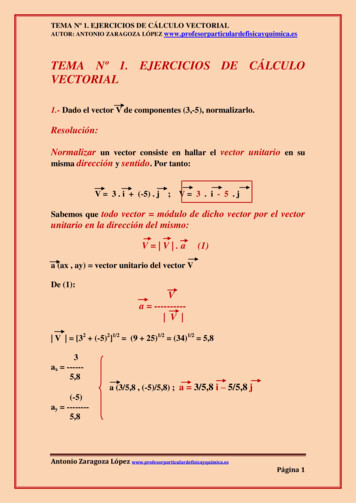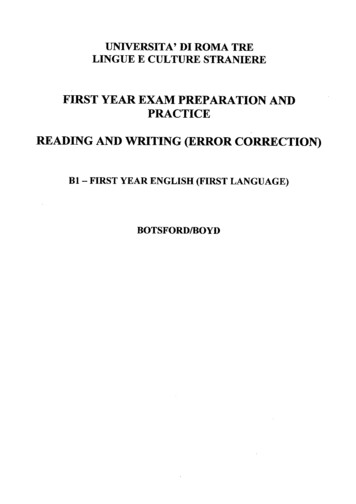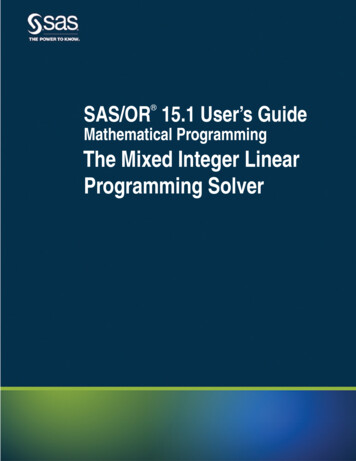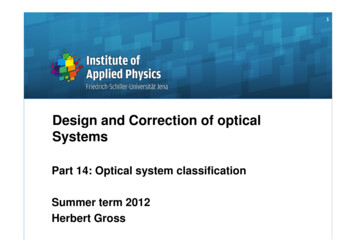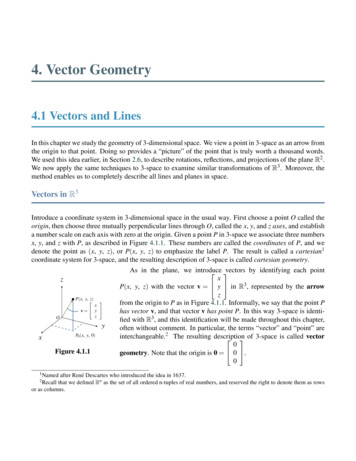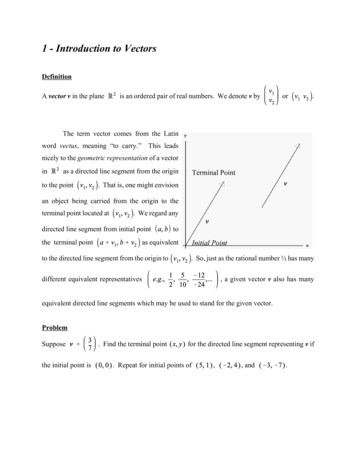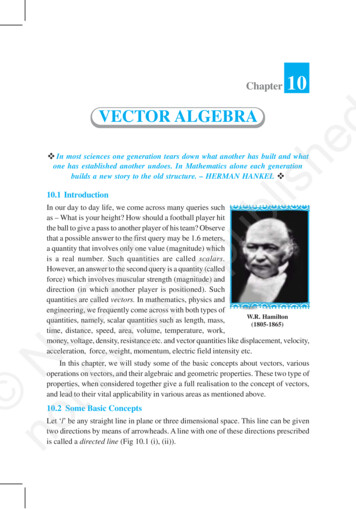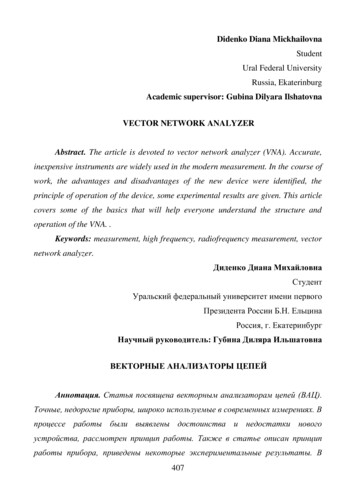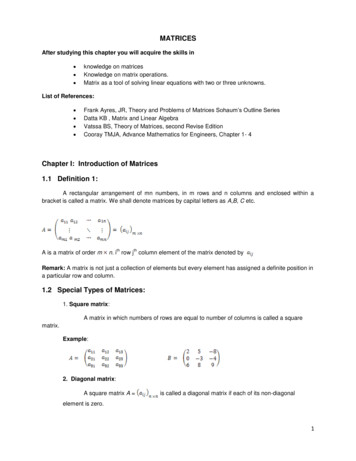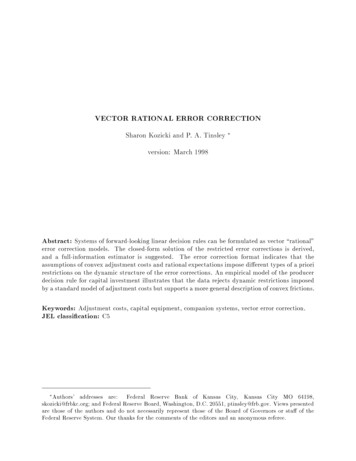
Transcription
VECTOR RATIONAL ERROR CORRECTIONSharon Kozicki and P. A. Tinsley 3version: March 1998Abstract: Systems of forward-looking linear decision rules can be formulated as vector \rational"error correction models. The closed-form solution of the restricted error corrections is derived,and a full-information estimator is suggested. The error correction format indicates that theassumptions of convex adjustment costs and rational expectations impose di erent types of a priorirestrictions on the dynamic structure of the error corrections. An empirical model of the producerdecision rule for capital investment illustrates that the data rejects dynamic restrictions imposedby a standard model of adjustment costs but supports a more general description of convex frictions.Keywords: Adjustment costs, capital equipment, companion systems, vector error correction.JEL classi cation: C53 Authors'addresses are: Federal Reserve Bank of Kansas City, Kansas City MO 64198,skozicki@frbkc.org; and Federal Reserve Board, Washington, D.C. 20551, ptinsley@frb.gov. Views presentedare those of the authors and do not necessarily represent those of the Board of Governors or sta of theFederal Reserve System. Our thanks for the comments of the editors and an anonymous referee.
11. IntroductionPolicy modeling in macroeconomics is complicated by theory, t, and exibility requirements.An in uential theoretical standard is that models should provide an explicit template ofrational decision making by economic agents. Typical data-based objectives for estimatedrelationships are to explain historical uctuations in macroeconomic aggregates and toforecast future movements. A third model requirement is to select exible speci cationsof features where economic priors are weak and data are scant, such as assumptions on theinformation and dynamic adjustment constraints of rms and households.Macroeconomic modelers are forced to make signi cant concessions in attempting tosimultaneously address these competing requirements. Thus, it is not surprising thatdi erent modeling strategies have evolved that better address one requirement more thanothers. Between the boundaries of data-based, atheoretic time series models, such as the VARspeci cations developed by Sims (1980), and of theory-based simulation models, discussed byKydland and Prescott (1996), are many hybrid modeling strategies. A de ning characteristicof these hybrid approaches is the introduction of su cient prior restrictions into data-basedspeci cations to enable coherent economic analysis of a particular issue. Examples of suchhybrid model methodologies range from the use of long-run priors in error correction models,discussed in Hendry (1995), to explicit assumptions regarding the timing of responses toinformation in structural VARs, reviewed in Watson (1994).This paper develops a hybrid modeling framework that provides a tractable bridgebetween data-based and theory-based modeling in the case of linear decision rules.Given that a system of linear decision rules for I(1) instruments is isomorphic to arestricted class of vector error correction (VEC) models, the purpose of this paper is toexamine the error correction equations implied by standard formulations of decision rules.The paper indicates that a subset of a priori dynamic restrictions, imposed by manyimplementations of intertemporal optimization, is generally rejected by error correctionmodels of macroeconomic aggregates.Discussion is organized as follows. Using the example of a single decision variable, section2 contrasts the role of a priori restrictions in conventional error correction models and in thestandard linear decision rules implemented in many existing macroeconomic models. Thecommon speci cation where convex adjustment costs are applied only to the of decisionvariables is suggested as a potential source of dynamic misspeci cation and of undesirableproperties in representative empirical estimates of decision rules in macroeconomics.A modeling framework for a more general description of frictions is presented in section3. A system of rational decision rules is derived for a vector of decision variables using thelevel
2extension of convex frictions to polynomial lag functions of decision variables suggested byTinsley (1993). For di erence-stationary variables, the resulting decision rules comprisea system of vector \rational" error correction equations (VREC) with cross-coe cientrestrictions due to convex frictions and cross-equation restrictions due to the assumptionof rational expectations. These restrictions are presented in analytic closed-form using asolution method based on lead and lag companion systems.Section 4, supplemented by subsections in the appendix, discusses full-informationmaximum likelihood estimation of the vector rational error correction system. A tractabletwo-step procedure is suggested, along with corrections of standard errors for the \generatedregressor" bias that is associated with two-step estimators. For cases where the forcingterms of Euler equations are in uenced by feedback from decision variables, model-consistentexpectations are imposed by mapping the decision rules into the forecasting system for theforcing terms.Section 5 provides an empirical example. The methodology is applied to a model ofproducers' investment in capital equipment with time-to-build constraints and convex costsof adjusting the rate of equipment installations. Section 6 concludes.2. Atheoretic and A Priori Descriptions of Dynamic AdjustmentFrom seminal work by Tinbergen in the 1930s to the present, the introduction of priors fromeconomic theory into linear dynamic models remains somewhat of an art form, subject tocycles in theoretical fashion as well as trends in analytical and computational techniques.In contrast to the \measurement without theory" trend and cycle decompositions ofprewar business cycle analysts, postwar researchers at the Cowles Commission indicated thateconomic theory can be a source of exclusion restrictions in constructing empirical models.Decision instruments are related to subsets of candidate explanatory variables by introducinga priori zero coe cient restrictions on both contemporaneous and lagged contributions ofselected regressors. However, because much of the inherited theory in macroeconomics isviewed largely a source of static priors about equilibrium relationships, the assessment bySims (1980) that dynamic exclusion restrictions were \incredible" stimulated widespread useof atheoretic VARs.In recent years, there has been a revival of interest in a priori restrictions to developstructural VARs where a priori zero restrictions are placed on the covariances of modeldisturbances, as reviewed by Watson (1994) and Canova (1995). In many instances, theserestrictions are equivalent to non-dynamic versions of exclusion conditions. Examples
3include a priori zero restrictions on contemporaneous coe cients, such as the restrictionsof current-period responses to shocks in Bernanke and Mihov (1995) and Christiano,Eichenbaum, and Evans (1996), and a priori zero restrictions on selected steady-statecoe cients, such as the long-run neutrality assumption in Blanchard and Quah (1989).In contrast to the structural VAR literature on static restrictions, this section discussestwo theory-based sources of dynamic restrictions. These restrictions are less frequentlyimplemented in estimated macroeconomic models due to an extensive literature, reviewedby Ericsson and Irons (1995), that suggests these restrictions are not supported bymacroeconomic data. These include restrictions associated with intertemporal optimizationunder convex frictions and restrictions imposed by an explicit forecast model of agentexpectations. Because agent expectations are generally unobserved, the assumption ofrational expectations (RE) is often invoked to equate the agent forecast model with thedata generating mechanism of the explanatory forcing variables. Although both sourcesof restrictions are collectively referenced as \RE overidentifying restrictions," this groupingmasks the di erent types of restrictions contributed by these assumptions and, thus, thesource of empirical rejections.The RE forecast assumption imposes cross-equation restrictions on dynamic coe cientsin the agent decision rule and dynamic coe cients in the agent forecast model of forcingvariables. By contrast, the intertemporal optimization assumption imposes lead and lagcross-coe cient restrictions that enforce similarities between the relative importance ofrecent and older shocks and the relative importance of nearby and distant anticipations.Discussion will indicate that conventional speci cations of frictions imply a priori zerorestrictions on certain dynamic coe cients when the decision rule is reformulated asa restricted error correction, and these zero restrictions are almost always rejected bymacroeconomic aggregates. For simplicity, only the case of a single decision variable isconsidered.2.1 Conventional error correctionTo establish notation, the decision variable of interest is y , the set of k explanatoryvariables is x0 [x1 ; x2 ; : : : ; x ], and a q-order VAR references q lags of each regressorin the kq 2 1 information vector of agents containing the explanatory variables, z0 01 [x0 01; x0 02; : : : ; x0 0 ]. Thus, in the case of an unrestricted VAR, the equation for y ist;tt;tk;tx;ttttqt
4represented byE 01 ytX a (L)x a (L)y 0 tk0yt1jjj;t 101 ; a0(L)y 01 a0z 01;(1)where E 01 denotes the expectation conditioned on agent information available at the end ofperiod t 0 1, a (L) denotes a (q 0 1)-order scalar polynomial in the lag operator, L x x 0 ,and a is the unrestricted kq 2 1 coe cient vector of the information vector, z 01.For stationary series, the equilibrium target for the decision variable implied by equation(1) isytx;ttijttix;ty3t (1 0 a0(1))01[ Xc xc yjj 1kjjk0X a (1)xj;tj;t 1];(2):In modeling the levels of variables, the assumption of di erence-stationarity, I(1), is notrejected for many macroeconomic aggregates. In these instances, the representation in thesecond line of equation (2) will denote the equilibrium path of the decision target establishedby cointegration analysis.In the case of a cointegrating target path, equation (1) can be rewritten as an errorcorrection description of the adjustment to the equilibrium path.1 0E 01 ytt(y 01 0 y301) b0(L)1y 01 tttX b (L)1xkjj 1j;t01 ; 0 (y 01 0 y301) b0(L)1y 01 b0R z 01:(3)The coe cients of the rst line in (3) are unrestricted. To enable later comparisons witherror correction formulations of decision rules, the second line references the informationvector, z 01. This more compact formulation requires a restriction matrix, R , to accountfor the rst-di erence formats of the corresponding regressors in the rst line.1As noted by Hendry (1995), many macroeconomic models estimated in the UnitedKingdom are error correction systems. An attractive feature of the error correctiontx;t1 Thettbx;tbrestriction matrix imposes k zero sum restrictions on the coe cients in b. Given the ordering ofvariables in the information vector, Rb Ikq 0 (Q Ik ), where each element of the q 2 q matrix, Q, is q01.Equivalently, Rb can be interpreted as transforming the regressors into deviations from q-period averages.
5speci cation is that additional \static" or equilibrium priors from economic theory, suchas long-run homogeneity of prices or Cobb-Douglas production, can be introduced into thecointegrating relation, equation (2). Indeed, use of prior information to identify long-runoutcomes is very useful for macroeconomists confronted by short samples. Also, as shown byHorvath and Watson (1992), the power of cointegration tests is improved for cointegrationswith known parameters.As with unrestricted VAR models, error correction models generally provide goodempirical ts of macroeconomic aggregates. While error correction models often satisfydata-based objectives of modelers, the absence of explicit distinctions between dynamics dueto adjustment costs and to revisions of agent forecasts precludes theory-based interpretationsof economic events based on rational agent responses to \news." In this sense, error correctionequations continue to inherit many of the theoretical limitations of traditional dynamicmacroeconomic models developed in the 1960s. As discussed by Lucas (1976) and Sargent(1981), models that weld together response dynamics and forecast dynamics into invariantlag structures are less well-suited for policy analysis than models that explicitly representbehavior as a consequence of rational planning by optimizing rms and households.2.2 Rational error correctionApart from signal extraction lters and scheduling or delivery lags, the main rationalizationof time series dynamics in macroeconomic models is that intertemporal optimizations ofutility or pro ts are subject to frictions on the adjustments of decision variables. In turn,for the case of linear decision rules, there are two interpretations of frictions. One, advancedby Calvo (1983), is that each agent is subjected to a distribution schedule of random delaysin adjustment, so that an agent's setting of a decision variable in a given period is, in e ect,a weighted average of desired target settings over the expected interval between allowableresets. The other, often attributed in macroeconomics to Eisner and Strotz (1963) in thecase of xed targets, is that movements of the decision variable are subject to quadraticadjustment costs, and these strictly convex frictions induce gradual adjustments toward thedesired target setting.2 In the simple cases usually implemented in macroeconomic models,either the assumption of a geometric distribution of random delays (constant hazard rate)or the assumption of a quadratic cost in adjusting the level of the decision variable produceobservationally equivalent decision rules, Rotemberg (1996).2 Additional references and discussion of issues in dynamic model interpretations of decision rules withdynamic forcing terms are found in Tinsley (1970, 1971).
6In the latter case, the representative agent selects a current setting for thedecision instrument that minimizes the expectation of a multiperiod criterion, y argmin(E 01 fCt g). Letting y3 denote the equilibrium settings that maximize pro ts or utilityin the absence of frictions, the standard quadratic tracking criterion trades o deviations fromequilibrium settings against the cost of adjusting the current level of the decision variable.1Ct B [(y 0 y3 )2 c1(y 0 y 01)2];(4) 0tttXitittiitiiwhere c1 denotes the cost of adjustment relative to the cost of disequilibrium, and B is axed discount factor, 0 B 1. In the case of a trending equilibrium path, adjustmentcost terms may be reformulated as costly deviations around expected trend growth to ensurethat planned settings converge to the target equilibrium path.With adjustment costs imposed only on changes in the level of the decision variable, theEuler equation that de nes the optimal current setting, y , is second-order,tf() ( )Et01 BF L yt0 (B ) (1)y3g 0;(5)twhere (BF ) 1 0 1 BF and (L) 1 0 1 L are scalar polynomials in the lead, F , and lag,L, operators, and 1 is the fractional solution of the equation, c1 1 [(1 0 1 )(1 0 1 B )].Most current data-based macroeconomic models are constructed using estimated Eulerequations of the form in equation (5)3 A less common approach is full-information maximumlikelihood estimation of macroeconomic decision rules where speci cation of the datagenerating process of the forcing term, y 3, is required. In early examples, such as theseminal study by Sargent (1978), autoregressive models of the forcing term were used.To facilitate term-by-term contrasts of the dynamic structures of optimal decision rulesand conventional error corrections, we will use the more general speci cation that the kPdeterminants of the forcing term are generated by a q -order VAR, E 01 x A x0 . 1Under rational expectations, this model matches the agent forecast model. Recast into arst-order companion form, the forecast model isqttjtjj3Et01 yt i3 Second-order 0 1 z 3 Hix;t01 :(6)Euler equations have been used extensively in macroeconomic policy models estimated inNorth America and elsewhere. Summary descriptions of several such models are provided in Bryant et al.(1993). In most instances, these are directly estimated by GMM-IV, although recent policy models also relyon calibration of simulation properties, such as sta models constructed for the Bank of Canada, Poloz etal. (1994), the Federal Reserve Board, Levin et al. (1997), and the Reserve Bank of New Zealand, Black etal. (1997),
7As before, z 01 denotes the kq 2 1 information vector of agents, 3 is a kq 2 1 selector vectorfor y 3, containing the relevant cointegration coe cients de ned in equation (2), and H is akq 2 kq top-row companion matrix of the forecast modelx;tt"H A1A2:::Aq0Ikq0q#:.As shown in Tinsley (1970), the optimal decision rule that satis es the Euler equationand the relevant endpoint (initial and transversality) conditions implies partial adjustmentto a discounted average of the forward equilibrium path. The decision rule solution canbe obtained by multiplying equation (5) by the inverse of the lead polynomial, (BF )01,expanding the forward summation of discounted forward targets, and substituting inforecasts of the expected target over the planning horizon from the model representing agentexpectations, equation (6). Following Tinsley (1993), the error correction format of theoptimal decision rule can be shown to beEt011y t0 (1)(y 01 0 y301) h03zttx;t(7)01;where the kq 2 1 coe cient vector of the agents' information set, z 01, is de ned by h3 00 01 (1)[H 0 I ][I 0 1 BH ] 3 .A term-by-term comparison of the conventional error correction in equation (3) with the\rational" error correction in equation (7) indicates two di erences in a priori restrictionson the dynamic formats:First, conditional on estimates of 1 from the coe cient of the cointegrating discrepancy,3y 01 0 y 01, of the xed discount factor, B , and of H from estimation of the forecast model,the kq 2 1 coe cient vector of the information vector, h3 , is completely determined. In otherwords, there are kq 0 k free parameters in the b R coe cient vector of the conventional errorcorrection, equation (3), but there are no free parameters in the h3 coe cient vector of thedecision rule, equation (7).Second, turning to the remaining terms, note that the q lags of the decision variable inthe conventional error correction, equation (3), are now replaced in equation (7) by the singlelag of the decision variable indicated in the lagged cointegrating discrepancy, y 01 0 y 301.Thus, the decision rule formulation, equation (7), imposes q 0 1 additional zero coe cientrestrictions on lags of the decision variable. Given estimates of the companion matrix, H , ofthe forecast model and the discount factor, B , the only free parameter in the rational errorcorrection, equation (7), is the adjustment cost parameter, 1 .x;tkqtkqt0btt
8One interpretation of the often disappointing empirical performances of conventionaltwo-root decision rules, including rejections of rational expectation restrictions, is simplythat expectations of actual agents may not be formed under conditions required for rationalexpectations, such as symmetric access to full system information by all agents. However,the limited dynamic speci cations illustrated in equation (7) suggest another contributingfactor the assumption that adjustment costs smooth only changes in the level of the decisionvariable. This imposes q 0 1 additional zero restrictions on the transfer function associatedwith y . To explore consequences of relaxing this arbitrary dynamic restriction, Tinsley(1993) suggests a generalization of frictions where costs of adjusting decision variables are afunction of a higher order polynomial in the lag operator or, equivalently, that the order ofthe relevant linear Euler equation is higher than the two-root example usually implementedin macroeconomics, such as equation (5).Two general interpretations of polynomial frictions and the associated higher-orderEuler equations are discussed by Tinsley (1997). One is to replace the single-parameter,exponential distribution of stochastic delays in Calvo (1983) with distributions of stochasticresponses that allow additional parameters (a nested case is the negative binomialdistribution). A second interpretation is that agents may aim to smooth weighted movingaverages of decision variables. A representative speci cation of the latter is when costsare associated with both the levels of assets and changes in time di erences (discrete-timederivatives) of assets. Examples of estimated decision rules with more than two eigenvaluesinclude many studies of inventory behavior, including Blanchard (1983), Callen, Hall, andHenry (1990), and Cuthbertson and Gasparro (1993). In this instance, convex penalties areassociated with changes in the rate of inventory investment due to production smoothing,given that planned inventory investment is the di erence between planned production andexpected sales. A more direct example is smoothing moving averages of decision variableswhen the periodicities of decision making are of lower frequencies than the periodicity ofobservations, as with seasonal or term contracts.In many applications, direct observations on average response times of agents can behelpful in assessing the consequences of a polynomial extension of adjustment costs andoften support higher-order speci cations. In addition, signi cance tests of friction parametersassociated with lags of the dependent variable in error correction formulations of the optimaldecision rule are useful in testing the standard assumption that adjustment costs applyonly to changes in the level of the decision variable. Use of both sources of information isillustrated in a later section
9The next section indicates that polynomial characterizations of frictions can be extendedto multiple decision variables to derive a general class of vector rational error correctionmodels.3. Multiple Decision Variables with Polynomial Adjustment CostsThis section develops error correction formulations of intertemporal decision rules where theprior that convex frictions apply only to levels of decision variables is replaced by a moregeneral speci cation of frictions. The analysis is also extended to the case of multiple decisionvariables.3.1 Derivation of the Euler equationsDenote the p21 vector of decision variables by y , and the corresponding vector of equilibriumtargets by y 3. The criterion that agents seek to minimize is extended to:ttCt Et1X01 f 0Bi[(y ti0 y3 )0C0(y 0 y3 ) (C (L)y )0(C (L)y )]g;ttiitti(8)tiwhere the cost function now contains a quadratic function of a matrix lag polynomial ofthe decision variables, C (L). As in the standard criterion shown in equation (4) for a singledecision variable, we assume C (1) 0 to maintain the distinction between targets andfrictions. The system of Euler equations for the criterion isEt01f(C0 C00 )(y 0 y3 ) C (L)0C (BF )y gtitti 0:iThe reciprocal structure of this system of rst-order conditions is illustrated for tworepresentative criteria. In the case of smoothing restrictions on moving averages of thedecision variables, the adjustment cost portion of the criterion is (C (L)y )0(C (L)y ) P((1 0 L )y )0 C ((1 0 L )y ) with the associated Euler equation systemtmk 1ktEt01ikktif(C0 C00 )(y 0 y3 ) tittXmik 1(C C 0 )((1 0 L )(1 0 BkkkkFk)y )g 0:tiSimilarly, in the case of smoothing restrictions on di erences (discrete-time derivatives) ofthe decision variables, the adjustment cost portion of the criterion is (C (L)y )0 (C (L)y ) P((1 0 L) y )0 C ((1 0 L) y ) with the associated Euler equation systemtmk 1kEt01tikktif(C0 C00 )(y 0 y3 ) titXmik 1(C C 0 )([(1 0 L)(1 0 BF )] y )g 0:kkktit
10As shown in these examples, the Euler equations are symmetric in L and BF , the rootsoccur in reciprocal pairs about the discount factor, and the Euler equation system has thealternative representation,4f() ( )Et01 A BF A L yt i0 A(B )A(1)y3 gti 0:(9)Note that this format is exactly the same as that used for the two-root Euler equation in (5)but A(:) is now an m-order matrix polynomial with p 2 p matrix coe cients in place of theearlier rst-order scalar polynomial (:).The system of p interrelated decision rules that satisfy the rst order condition in (9) is:Et011y t0A(1)(y 01 0 y301) A3(L)1y 011X 70 [I 0 G]01 G 7 A(B )A(1)E 011y 3 ;ttt(10)jmmpjm 0ttjwhere G is the mp 2 mp bottom-row companion matrix associated with A(BF ).26666G 66640A00.0m0Bm0A001 Bm1111110IpIp01m0A001 B02mm00.111 I1 1 1 0A1Bp3777777 :75The derivation of equation (10), including the de nition of the selector matrix, 7 , isprovided in section A.1 of the appendix. Aside from computational simplicity, a considerableadvantage of this representation for statistical inference is that it delivers a closed formsolution that preserves the parameters of the adjustment cost matrix polynomial withouttransforming to eigenvalue forms or resorting to numerical solution methods.5m3.2 Adding a lag companion forecast system for the forcing termsTwo sets of variables are in the agents' information set: the decision variables, y and aremaining set of non-decision information variables that re ect the economic environment ofthe agents, x . The information variables may be exogenous or may be subject to feedbackin uences from the agents' decision variables.tt4 See discussion of self-reciprocal polynomials in Tinsley (1993).5 Representative methods for obtaining linear decision rules from Euler equation systems range from partialfractions expansions of the characteristic roots in Hansen and Sargent (1980) to Schur decompositions inAnderson and Moore (1985) and Anderson, Hansen, McGratten, and Sargent (1996).
11The dynamic evolution of information variables, x , is represented by a reduced formmodel in which forecasts of x depend on the information available to agents at the end ofperiod t 0 1.tt Et01 xt(11)Hx zt01:The n 2 1 information vector, z 01, contains lagged observations on y 0 and x 0 ; j 1; : : : ; q .In the case of equilibrium path variables, each element of the p 2 1 vector, y 3, is assumedto be a linear combination of decision and information variables in the agent informationset. These p relationships are represented byttjtjt3 00 z ;3yt(12)twhere the i column of 03 contains the coe cients used to de ne y 3 . Because equilibriumtargets are often de ned as functions only of contemporaneous observations, leavingdepartures from equilibrium to be attributed to adjustment costs, 03 is usually quite sparse,with zero coe cients on all lagged information in z . In cases where the targets are linearlyrelated to contemporaneous values of exogenous I(1) variables in x , it is often convenient toassume that the equilibrium paths are identi ed by prior cointegration analysis and includedexplicitly in the information vector, z ; in these instances, 03 is simply a selector matrix,much like 7 , containing relevant unit and zero elements.Finally, to formally account for motion of the decision variables, y , the decision rules inthe system (10) are denoted bythittttmt Et01 yt(13)Hy zt01 :Of course, the matrix, H , is tightly restricted, as shown below.The two reduced form forecast models in (11) and (13) can be stacked to de ne thecompanion form of the full forecast modely Et01 zt iH 1 zit(14)01:Substituting the equations for equilibrium targets from (12) and the forecasts of variablesin the information set from (14) into the decision rule system, (10), shows the relationshipbetween planned movements in the decision variables and the agent information setEt011y t0A(1)(y 01 0 y301) A3(L)1y 01t [70 (Immpt0 G)011X 0itGi7m( ) (1)003H (H 0 I )]z 01:A B Aint(15)
12It is useful to compare the structure of this solution for the set of decision rules to thestandard format of an unrestricted vector error correction model,0A(1)(y 01 0 y301) A3(L)1y 01 H 3 z 01:(16)In conventional error corrections, H 3 is an unknown p 2 n matrix whose nonzero elementsEt011y ttttyztyzare coe cients of series in the agent information set, z 01 , including lagged targets andinformation variables. As with the error correction equation (3) in section 2, contributionsof lagged regressors in the information vector, z 01 , are often interpreted as decision variableresponses to forecasts of the economic environment of agents although no explicit use ismade of the forecast model, equation (14).6 Note that if equilibrium forcing variables are notindependent of feedback e ects from decision variables, then H 3 may also contain nonzerocoe cients of lagged decision variables. Within the standard vector error correction format,it is impossible to disentangle the contributions of adjustment costs, summarized in the termsassociated with the matrix polynomial, A(:), and lagged feedback e ects on the forcing terms.Inspection of the last term in (15) indicates that the lengthy expression in the brackets,[ : ], likewise de nes the coe cients of the information vector, z 01, for rational decisionrules. Thus, the set of decision rules can be rewritten in a compact format similar to thatin equation (16).tiyztEt010A(1)(y 01 0 y301) A3(L)1y 01 H1y ttttyzzt01 ;(17)where each row of H prescribes the in uence of variables in the information set on aparticular decision variable. However, in contrast to matrix H 3 in the unrestricted vectorerror corrections of (16), each row of the matrix H in the decision rule equations of (17) istightly restricted.To show the restrictions imposed on H , the j row is extracted by premultiplying Hby a 1 2 p sele
Sharon Kozicki and .P A. Tinsely version: March 1998 Abstact: Systems of forward-looking linear decision rules can be formulated as vector \rational" . Authors' ddraesses are: ederaFl Reserev Bank of Kansas ,City Kansas City MO 4198,6 skozicki@frbkc.org; and ederalF Reserve Board, ashington,W D.C. 0551,2 ptinsley@frb.gov. Views presented .

